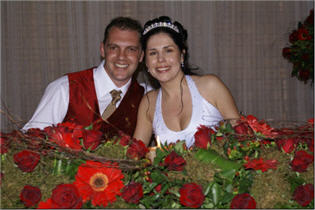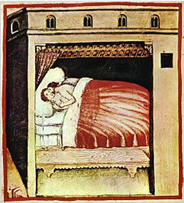
Almost every part of a wedding, from the engagement to the honeymoon, has rich a history and cultural roots. The customs go back to ancestry and religious beliefs that shaped marriages for thousands of years.
The Wedding
The wedding is one of life’s ancient and surprisingly unchanged rites of the past. Almost all of the customs we observe today are carried over from the past. Everything from the veil, rice, flowers, and old shoes, to the bridesmaids and processionals, at one time, had a very specific and significant meaning. Today, although the original substance is often lost, we incorporate old world customs into our weddings because they are fun, traditional and ritualistic.
Finding a bride
In ancient times the groom often kidnapped his bride to be from the family. The first ushers and best men were more like a small army, fighting off the brides angry relatives as the groom rode away with her.
Elopement was one of the most frequent practices of marriage by mutual love. In primitive times, elopement was almost impossible because women were guarded too well. Parents and guardians arranged a marriage to suit their own greedy needs, without thought for the desires or happiness of the bride-to-be. Elopement gradually became a viable alternative to marriage by capture or by purchase. To avoid marrying a man she disliked but who was able to pay the price her parent’s demanded, a young woman could decide to elope with the man of her choice.
The Best Man
Before women had more rights, men who decided upon a wife often had to kidnap her if her family did not approve of him. The tradition of a “best man” probably has its origin with the Germanic Goths, when it was customary and preferable for a man to marry a woman from within his own community. When women came into short supply “locally,” eligible bachelors would have to seek out and capture a bride from a neighbouring community. The best man had to assist in capturing the bride and fending off her angry family.
The Wedding Party
Bridesmaids and maids of honour became more common when weddings were planned. For several days before the marriage, a senior maid attended to the bride-to-be. This maid or matron of honour, as we know her today, ensured that the bridal wreath was made and helped the bride get dressed. All bridesmaids helped the bride decorate for the wedding feast.
Wedding Flowers
To drive evil spirits away as they walked down the aisle women carried aromatic bunches of garlic, herbs, and grains. Today we use flowers in the bridal bouquet symbolising fertility and everlasting love.
The Bouquet
In the beginning, the bouquet formed part of the wreaths and garlands worn by both the bride and groom. It is still considered to be a symbol of happiness. Originally bridal wreaths and bouquets were made of herbs, which had magical and meaningful outcomes for the couple’s future life.
If a bride carried sage (the herb of wisdom) she became wise; if she carried dill (the herb of lust) she became lusty. Flower girls carried sheaves of wheat, a symbol of growth, fertility and renewal. Later flowers replaced herbs and took on meanings all their own. Orange blossoms, for example, mean happiness and fertility. Ivy means fidelity and lilies mean purity.
Hand-fasting
The old way in Great Britain for couples to pledge their betrothal was for them to join hands, his right to her right, his left to her left, so from above they looked like an infinity symbol. Done in front of witnesses, this made them officially “married” for a year and a day, following which they could renew permanently or for another year and a day.
Traditionally, the bride stands to the left side of the groom. This was meaningful etiquette. Among the Northern European barbarians (a name given to them by the Romans), a groom placed his captured bride to his left to protect her and kept his right hand free to use for defense.
Something old, something new, something borrowed, something blue, and a silver sixpence in her shoe
This good luck saying dates back to Victorian times and many brides try to arrange their wedding attire accordingly. Something old represents the link with the bride’s family and the past. Many brides choose to wear a piece of antique family jewellery or a mother’s or grandmother’s wedding gown. Something new represents good fortune and success in the bride’s new life. The wedding dress is often chosen as the new item. Something borrowed is to remind the bride that friends and family will be there for her when help is needed. The borrowed object might be something such as a lace handkerchief. Something blue is the symbol of faithfulness and loyalty. Often the blue item is the garter. A silver sixpence in her shoe is to wish the bride wealth.
Veils
The veil originally symbolized the bride’s virginity, innocence, and modesty. The veil can be traced back to Roman times when it was a complete head to toe cover (that could be later used as her burial shroud!).
The White Wedding Dress
In biblical days, blue not white represented purity, and the bride and groom would wear a blue band around the bottom of their wedding attire hence “something blue”.
White was made popular in the 1840’s by Queen Victoria, who chose this instead of the traditional royal “silver” wedding dress. Prior to this brides simply wore their best dress on their wedding day.
The Bride’s Garter
 The garter from the bride comes from the ancient custom of witnesses at the marriage bed to ensure the couple consummated the marriage. The witnesses would bring it forth as a sign of the consummation. It became such a violation of privacy that eventually the bride would have the groom throw it to prove consummation.
The garter from the bride comes from the ancient custom of witnesses at the marriage bed to ensure the couple consummated the marriage. The witnesses would bring it forth as a sign of the consummation. It became such a violation of privacy that eventually the bride would have the groom throw it to prove consummation.
The Wedding Cake
Originally, the cake was not eaten by but thrown at the bride as one of the many fertility traditions surrounding a wedding!
Early Roman bakers, we are told, changed the “throw it” to the “eat it” tradition. These bakers were distinguished and respected in their trades. Somewhere around 100 BC they began taking the wedding wheat and creating small, sweet cakes with it; the cakes were eaten while the service was in progress.
The Wine/Champagne Toast
Throughout the ages, wine has been used for celebration. For many people wine signifies life, vitality, love and a life of plenty. Drinking wine from a common cup has been the intimate mark of deep sharing. “Entwined as the Vine”.
Honeymoons
In ancient times, the German Teutonic tribe began the practice of the honeymoon. Teutonic weddings were only held under the full moon. After the wedding the bride and groom would drink honey wine for one full moon cycle of thirty days. This “moon” or “month” became known as the “honey moon.”
Irish Marriage Blessing
May God be with you and bless you;
May you see your children’s children.
May you be poor in misfortune,
Rich in blessings,
May you know nothing but happiness.
From this day forward
Make your wedding memorable and happy
You can plan the wedding of your dreams according to your culture, traditions, personal taste and budget. No bride or groom would like their wedding to be boring or a disaster. Make sure that you plan your wedding well by making use of imagination, good advice and planning.
If you live in South Africa call Ena now to help you with the decor for a memorable wedding at 012-6543826 or cell 0834503799